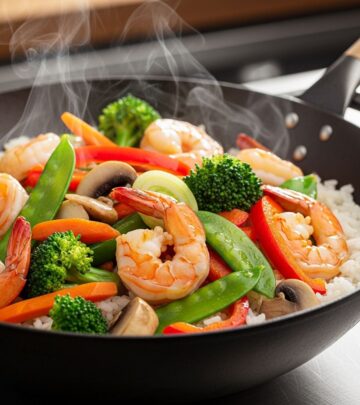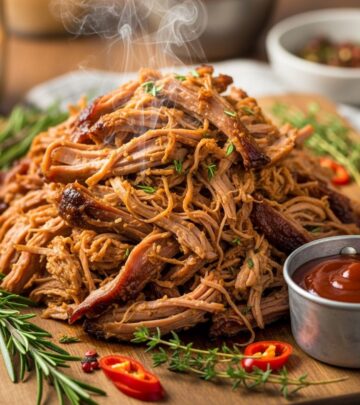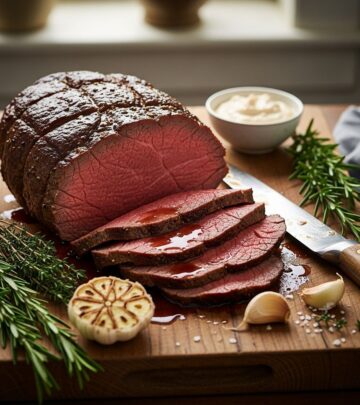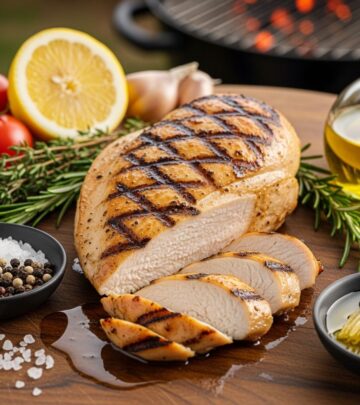Homemade Garam Masala Recipe: 7 Essential Spices In Minutes
Discover how to make authentic garam masala at home with simple ingredients for perfect Indian dishes.

Image: HearthJunction Design Team
Easy Homemade Garam Masala: The Essential Indian Spice Blend
If you’ve ever cooked Indian cuisine or explored recipes from the Indian subcontinent, you’ve likely encountered garam masala. This aromatic spice blend is a cornerstone of Indian cooking, adding depth, warmth, and complexity to countless dishes. While pre-packaged versions are readily available in stores, nothing compares to the vibrant flavors of a freshly made homemade blend. The good news? Making your own garam masala at home is surprisingly simple, requiring just a handful of common ground spices and mere minutes of your time.
This easy garam masala recipe will quickly become a staple in your kitchen, elevating your Indian cooking to new heights of authenticity and flavor. Whether you’re preparing a weeknight curry, a festive biryani, or simply looking to expand your culinary horizons, having a jar of homemade garam masala on hand will transform your dishes from ordinary to extraordinary.
What Is Garam Masala?
Garam masala is a traditional Indian spice blend that has been used for centuries in South Asian cuisine. The name itself provides insight into its character: in Hindi, ‘garam’ translates to ‘hot’ or ‘warm,’ while ‘masala’ means ‘spices.’ However, this doesn’t necessarily indicate that the blend is spicy in the sense of heat or pungency. Rather, the ‘warmth’ refers to the aromatic nature of the spices and their warming effect on the body according to Ayurvedic principles.
Unlike some other spice blends that focus on heat, garam masala emphasizes aromatic qualities and complex flavor profiles. The combination of spices creates a harmonious blend that adds depth and dimension to dishes without overwhelming them with spiciness. Each region of India has its own variation of garam masala, with different proportions and sometimes different ingredients altogether, reflecting the diverse culinary traditions across the country.
What makes garam masala special is its versatility and balance. The blend typically combines sweet, bitter, pungent, and earthy flavors in perfect harmony. While store-bought versions offer convenience, they often lack the vibrancy and nuance of a freshly prepared homemade blend. By making your own, you can adjust the proportions to suit your taste preferences and ensure maximum freshness and potency.
What Is In Garam Masala?
The beauty of garam masala lies in its balanced combination of aromatic spices. While recipes can vary significantly by region and family tradition, most versions share a core set of ingredients that create the distinctive flavor profile. This easy recipe uses readily available ground spices, making it accessible for home cooks without specialized equipment or access to exotic ingredients.
These are the ground spices you’ll need to make this garam masala recipe at home:
- Ground Cumin (1 tablespoon): Provides earthy, warm undertones and is one of the foundation spices in the blend.
- Ground Coriander (1 ½ teaspoons): Offers citrusy, slightly sweet notes that balance the more pungent spices.
- Ground Cardamom (1 ½ teaspoons): Contributes a unique sweet and floral character with hints of mint and lemon.
- Ground Black Pepper (1 ½ teaspoons): Adds a gentle heat and pungency that enhances the other flavors.
- Ground Cinnamon (1 teaspoon): Brings sweetness and warmth with its distinctive aroma.
- Ground Cloves (½ teaspoon): Imparts a strong, pungent character with sweet undertones.
- Ground Nutmeg (½ teaspoon): Completes the blend with its sweet, nutty, and slightly spicy profile.
While this recipe uses pre-ground spices for convenience, traditional garam masala is often made by toasting whole spices and then grinding them together. This process intensifies the flavors and aromas, creating a more potent blend. However, using good quality pre-ground spices still produces excellent results, especially when you’re short on time or don’t have access to a spice grinder.
How to Make Garam Masala
One of the greatest advantages of this easy garam masala recipe is its simplicity. Unlike traditional methods that require toasting and grinding whole spices, this version streamlines the process without significantly compromising on flavor. With just a few minutes of your time, you can create a spice blend that will enhance your cooking for weeks to come.
Ingredients You’ll Need:
- 1 tablespoon ground cumin
- 1 ½ teaspoons ground coriander
- 1 ½ teaspoons ground cardamom
- 1 ½ teaspoons ground black pepper
- 1 teaspoon ground cinnamon
- ½ teaspoon ground cloves
- ½ teaspoon ground nutmeg
Step-by-Step Instructions:
- Gather all ingredients: Measure out all your ground spices and have them ready.
- Combine the spices: In a small mixing bowl, add the ground cumin, coriander, cardamom, black pepper, cinnamon, cloves, and nutmeg.
- Mix thoroughly: Using a small whisk or spoon, stir the spices together until they’re well combined and evenly distributed. Make sure to break up any clumps for a uniform blend.
- Store properly: Transfer your freshly made garam masala to an airtight container, such as a small glass jar with a tight-fitting lid.
- Label and date: To keep track of freshness, label your container with the date you made the blend.
That’s it! Your homemade garam masala is ready to use in your favorite Indian recipes. The entire process takes less than five minutes, yet the impact on your cooking will be significant and long-lasting.
Tips for Making the Best Garam Masala
While this recipe is straightforward, a few key considerations can elevate your homemade garam masala from good to exceptional:
- Use fresh spices: The quality of your garam masala depends directly on the freshness of the individual spices. Ground spices typically maintain their potency for about 6 months, so check your spice cabinet and replace any that have been lingering too long.
- Consider toasting pre-ground spices: For enhanced flavor, you can lightly toast the pre-ground spices in a dry skillet over low heat for 1-2 minutes until fragrant before mixing. Be careful not to burn them, as this will create bitterness.
- Customize to your taste: Don’t be afraid to adjust the proportions to suit your preferences. If you particularly enjoy the floral notes of cardamom, you might add a bit more, or if you find cloves overpowering, you could reduce that amount slightly.
- Make small batches: Spice blends are at their most aromatic when freshly made. Rather than making large quantities that might lose potency over time, consider making smaller batches more frequently.
- Store properly: Keep your garam masala in an airtight container away from heat, moisture, and direct sunlight to preserve its flavors longer.
How to Use Garam Masala
Unlike some spice blends that are added at the beginning of cooking, garam masala is typically incorporated toward the end of the cooking process. This timing preserves its delicate aromas and ensures that the flavors remain vibrant in the finished dish. The warmth and complexity of garam masala make it a versatile addition to many different recipes.
Here are some classic ways to use your homemade garam masala:
- Curries and stews: Add a teaspoon or two during the last 5-10 minutes of cooking to infuse the dish with aroma and flavor.
- Rice dishes: Sprinkle into biryanis and pulaos for an authentic touch.
- Vegetables: Toss roasted or sautéed vegetables with a pinch of garam masala before serving.
- Marinades: Include in yogurt-based marinades for chicken, lamb, or paneer.
- Dals (lentil dishes): Stir into simmering lentils for added depth.
- Finishing touch: Use as a garnish sprinkled over completed dishes just before serving.
Some popular Indian dishes that showcase garam masala include:
- Chicken Biryani: A fragrant rice dish with marinated chicken and aromatic spices.
- Butter Chicken (Makhani Chicken): Tender chicken in a rich, creamy tomato-based sauce.
- Chana Masala: Spiced chickpea curry with a tangy tomato base.
- Vegetable Samosas: Savory pastries filled with spiced potatoes and peas.
- Dal Makhani: Creamy black lentils slow-cooked with butter and spices.
The versatility of garam masala extends beyond traditional Indian cooking. Creative cooks have found ways to incorporate this aromatic blend into non-Indian dishes as well, such as roasted root vegetables, pumpkin soup, or even spiced cookies and cakes for an unexpected twist.
Storage and Shelf Life
To maintain the vibrant flavors of your homemade garam masala, proper storage is essential. When stored correctly, your spice blend will remain aromatic and flavorful for several months.
Follow these guidelines for optimal freshness:
- Container selection: Store your garam masala in an airtight container, preferably made of glass or ceramic rather than plastic, which can absorb aromas.
- Environment: Keep the container in a cool, dry place away from direct sunlight, which can degrade the spices faster.
- Avoid moisture: Always use a dry spoon when scooping out the blend to prevent introducing moisture, which can lead to clumping or even mold.
- Expected shelf life: While your homemade garam masala will remain safe to use indefinitely, its potency and aroma will gradually diminish. For best flavor, use within 3-4 months.
- Freshness test: If you’re unsure about the freshness of your blend, perform a simple aroma test. Rub a small amount between your fingers and smell – if the aroma is weak or absent, it’s time to make a fresh batch.
Frequently Asked Questions (FAQs)
Q: Can I use whole spices instead of ground spices for this recipe?
A: Absolutely! Using whole spices and toasting them before grinding will produce an even more flavorful garam masala. Simply toast the whole spices in a dry skillet until fragrant, cool completely, and then grind in a spice grinder or mortar and pestle. Adjust the quantities accordingly, as whole spices will yield different volumes when ground.
Q: Is garam masala spicy hot?
A: Despite the name “garam” meaning “hot,” garam masala is not typically spicy in terms of heat. The “hot” refers more to the warming effect of the spices on the body rather than capsaicin-type heat. The blend is aromatic and flavorful but not particularly spicy like chili peppers would be.
Q: Can I substitute garam masala for curry powder?
A: While both are spice blends used in Indian cooking, they have different flavor profiles and are not direct substitutes. Curry powder often contains turmeric (giving it a yellow color) and typically has a more uniform flavor. Garam masala is more aromatic and complex. However, in a pinch, you can use one for the other, recognizing that the flavor profile of your dish will be different.
Q: How is garam masala different from other Indian spice blends?
A: Garam masala differs from other Indian spice blends like chaat masala or tandoori masala in its composition and use. It focuses on warming, aromatic spices rather than tangy or hot ones. Additionally, garam masala is typically added toward the end of cooking to preserve its aromatic qualities, while many other blends are used earlier in the cooking process.
Q: Can I adjust the proportions of spices in this recipe?
A: Absolutely! One of the benefits of making your own garam masala is the ability to customize it to your taste preferences. If you particularly enjoy certain spices or find others too dominant, feel free to adjust the proportions accordingly. Many families in India have their own specific recipes that have been passed down through generations.
Creating your own garam masala at home is a simple yet rewarding culinary project that will enhance your cooking and bring authentic Indian flavors to your kitchen. With just a handful of common spices and a few minutes of your time, you can craft a versatile spice blend that will elevate countless dishes. Experiment with different proportions, explore various applications, and discover the transformative power of this ancient spice tradition in your modern kitchen.
References
Read full bio of Anjali Sayee












